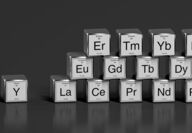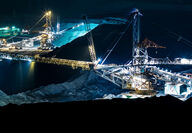Sorted by date Results 1 - 25 of 25

A hardener of the steels that have been helping to make Fords tough for more than a century and an element with unique properties that make it the key ingredient in enormous batteries to store intermittent wind- and solar-generated electricity, vanadium is a critical metal with many valences. It is vanadium's chemical valences that make this alloying metal an ideal ingredient in the redox flow batteries that scientists and governments see as the ideal large-scale storage...

Canada is positioning itself as the "global supplier of choice" for the critical minerals and metals essential to tomorrow's technologies, especially the almost unfathomable quantities of raw materials that will be required by a world transitioning to low-carbon energy and electric vehicles. "Demand for minerals and metals continues to grow with an increasing focus on critical minerals – vital in aerospace, healthcare, telecommunications and an array of clean technologies such...

Typically thought of as a precious metal used to make coins, jewelry, tableware, and other glimmery objects, silver's true value lies in more industrious properties that make it invaluable to high-tech applications such as solar panels, electric vehicles, and 5G networks. Roughly 28% of the 8,000 metric tons (257.2 million ounces) of silver used in the United States during 2020 went into electrical and electronics devices; 26% into jewelry and silverware; 19% for coins and...

While the history of human innovation is a series of discoveries, each building on the last, there are certain "eureka moments" that mark a shift in the trajectory of mankind – taming fire, stone toolmaking, Bronze Age metalworking, the printing press, and harnessing electricity to name a few. The history books may one day reflect on these opening decades of the 21st century as one of those rare occasions that human innovation makes a leap that necessitates a new chapter be w...

The global transition to electric vehicles plugged into renewable energy sources is powering enormous demand for graphite, the single largest ingredient in lithium-ion batteries. "Graphite demand increases in both absolute and percentage terms since graphite is needed to build the anodes found in the most commonly deployed automotive, grid, and decentralized batteries," the World Bank penned in a 2020 report, "The Mineral Intensity of the Clean Energy Transition." According...

From the advancements of technology during the Bronze Age to the computers and telecommunication systems of today's Big Data Era, tin has been critical to human progress for at least 5,500 years. Sometime around 3500 BC, Sumerians living in modern day Turkey and Iran discovered that mixing a little tin with copper created bronze, an alloy that produced much more durable weapons and tools than those cast from copper alone. This cutting-edge discovery offered a strategic and...

Considering the almost unfathomable quantities that will be needed to power the global shift to low-carbon energy and electric mobility, copper is the most critical of the minerals and metals that have not been deemed critical by the United States or the European Union. How much demand will it take to push an abundant and widely produced metal like copper to the level of criticality? A doubling of current demand would likely be sufficient, and many analysts are forecasting...

The envisioned green future where every North American is driving a battery-powered electric vehicle charged with renewable energy could be undermined by cobalt, a somewhat scarce and controversial metal that makes lithium-ion batteries better. "Cobalt is considered the highest material supply chain risk for electric vehicles in the short and medium term," the U.S. Department of Energy penned in an April report. This risk has automakers, lithium-ion battery manufacturers, and...

Though it is tough to distinguish the nearly identical properties of niobium and tantalum in nature, at the workplace, one of these critical twin metals typically dons a hardhat and boots to work in the construction and energy industries while you are more apt to find the other working in the high-tech sector. Their differences, however, are subtle, and their careers sometimes overlap. "The leading use of niobium is in the production of high-strength steel alloys used in pipel...

Scandium is an adopted brother to the family of 15 lanthanides that make up the suite of elements known as rare earths. While it may not have quite as strong a chemical bond to its adopted lanthanide siblings as they do to each other, scandium does possess similar characteristics and is almost always found at the same geological gatherings (deposits) as the rest of its rare earth family. Beyond its close chemical and geological ties to rare earths, scandium is considered a...

From the transistors in quantum computers that are millions of times faster than their classical counterparts to fiber optic cables that send data at the speed of light, germanium is a little-known semiconductor that is a small but extremely important ingredient in the technologies behind the future of ultrafast computing and communications. Germanium traces its technological roots back to the 1950s, when scientists developed the transistor to replace vacuum tubes in the...

Lightweight, strong, and resistant to corrosion, titanium is best known for the properties it lends to rockets, aircraft, and high-performance sports equipment. Only about 3% of the more than 8 million metric tons of titanium minerals mined each year globally, however, go into high strength-to-weight ratio and corrosion-resistant alloys. What does drive the mass majority of the demand for this critical mineral is "enwhitening." According to the United States Geological...

Overshadowed by headline-grabbing rare earth elements, gallium is an underappreciated critical metal that is a vital ingredient in next-generation smartphones and communication networks, light-emitting diodes (LEDs), thin-film solar cells, and medical devices. "The development of gallium arsenide as a direct band-gap semiconductor in the 1960s led to what are now some of the most well-known uses of gallium – in feature-rich, application-intensive, third- and f...

Amongst the rarest of the stable elements on the periodic table and an important ingredient in the emerging thin-film solar panel sector, tellurium embodies what it means to be a critical metalloid – an element that possesses the properties of both a metal and non-metal. "Most rocks contain an average of about 3 parts per billion tellurium, making it rarer than the rare earth elements and eight times less abundant than gold," the United States Geological Survey wrote in a 2...

The ability to type, tap, swipe, and scroll your way through articles such as this one from a smartphone, tablet, computer, and now even refrigerators is made possible by indium-tin oxide, which is used as a transparent conducting film applied to virtually every flat-panel display and touchscreen on the market. This thin and invisible layer lying just under the glass senses incoming electrical data triggered by the touch of your fingertip and transforms it into an optical...

"Please mine more nickel," these four words from Tesla CEO Elon Musk reverberated across the global mining sector and raised awareness of how fundamental nickel is to the lithium-ion batteries powering hundreds of millions of electric vehicles to come off Tesla and traditional automaker assembly lines over the next two decades. "Tesla will give you a giant contract for a long period of time if you mine nickel efficiently and in an environmentally sensitive way," Musk implored...

Global governments and industries are setting increasingly ambitious targets for the phasing out of fossil fuel-burning automobiles in favor of electric vehicles charged with green energy. Achieving these grand climate objectives, however, is going to require an equally bold strategy to ensure there are plentiful supplies of the new generation of energy minerals and metals critical to building this revolution in the way the world generates and uses energy. The World Bank...

Extremely hard and with the highest melting point of all the metals, tungsten's toughness is legendary. Like many of the other metals that have found their way onto critical mineral lists in Canada, Europe, and the United States, this durable metal is vulnerable to Chinese control. "World tungsten supply was dominated by production in China and exports from China," the U.S. Geological Survey inked in its 2021 mineral commodities report. It is estimated that mines in China...

From jewelry at a black-tie soiree to scrubbing harmful emissions from the exhaust system of a farm truck, the six platinum group metals – platinum, palladium, rhodium, ruthenium, iridium, and osmium – are metals that are both precious and critical to the United States and Canada. Extremely rare, durable, and with a brilliance that does not tarnish, platinum and other metals in its group are a treasured choice for high-end jewelry that stands the test of time. Three of the...

Roughly 38,000 metric tons of rare earth concentrates were produced from American soil during 2020, yet the United States remains 100% reliant on foreign countries for its supply of these 17 elements critical to our modern high-tech society – an apparent paradox that speaks to the complexities of these enigmatic metals. The irony of rare earth elements (REEs) begins with their name, which is at the same time a misnomer and accurate descriptor. "All the REEs except p...

An unsung war hero that saved countless American troops during World War II, an overlooked battery material that has played a pivotal role in storing electricity for more than 100 years, and a major ingredient in futuristic grid-scale energy storage, antimony is among the most important critical metalloids that most people have never heard of. While antimony may not be part of the common lexicon, humans have been using this semi-metal for more than 5,000 years. "For example,...

The lightest of all the metals in the universe, lithium has emerged as the namesake for the batteries powering electric vehicles down global highways and storing renewable energy for those EVs to plug into. This is on top of the countless laptops, tablets, smartphones, wearable electronics, power tools, household appliances, electric bikes, scooters, toys, and the seemingly endless list of electric devices made possible by lithium-ion batteries. "Lithium consumption for...

Reminiscent of America's gilded age, the world is priming itself for a new era of technology and energy centered on the electricity that sparked the imaginations of visionaries such as Nikola Tesla and Thomas Edison. This new era, however, sets aside more than a century of burning fossil fuels in favor of new clean sources of the electricity that will power human innovation into the 21st century and beyond. Solar, wind, hydro, and geothermal are but a few of the methods...

From electric vehicles plugged into renewable energy to smartphones connected to 5G networks, new technologies take advantage of the special properties of a suite of critical minerals and metals that are often rare and in short supply. In addition to the rare earths, cobalt, lithium, and other technology metals that capture headline attention, this list includes even more obscure mined materials such as gallium, germanium, scandium, and tellurium. While scarce, these critical...

A heavy reliance on imports for a long list of minerals and metals critical to American supply chains could be a stumbling block for the Biden administration's ambitious "Build Back Better" agenda. "From the largest infrastructure plan since the Eisenhower interstate highway system, to an aggressive plan for a national energy transition, the Biden administration's agenda will require an immense amount of minerals," National Mining Association President and CEO Rich Nolan...